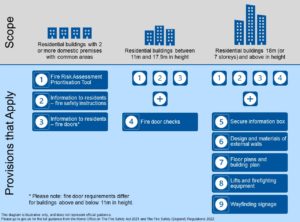The Fire Safety Act 2021 came into force on 16 May 2022. It amends the Regulatory Reform (Fire Safety) Order 2005, clarifying that – in a multi-occupied residential building, containing two or more sets of domestic premises – the Order applies to:
- The building’s structure and external walls (including windows, balconies, cladding, insulation and fixings) and any common parts; and
- All doors between domestic premises and common parts, such as flat entrance doors (or any other relevant door).
The UK Government has now introduced the Fire Safety (England) Regulations 2022, which seek to implement several recommendations from Phase 1 of the Grenfell Tower Inquiry. The regulations came into force on 23 January 2023.
The Regulations introduce new requirements for multi-occupied residential buildings, and different regulations apply depending on a building’s height.

Follow the menu links for more information about the different requirements:
- Residential buildings with two or more domestic premises
- Residential buildings 11m and higher
- Residential buildings 18m and higher
- Reporting requirements under the new Regulations
The National Fire Chiefs Council (NFCC) has collated some frequently asked questions about the Fire Safety (England) Regulations 2022.
Fire Door Installers
The importance of a properly installed and maintained fire door can never be stressed enough. Fire doors provide lifesaving passive protection from the effects of both heat and smoke.
When a fire door is beyond repair, you will need to replace the door. The following are examples of how this fire service recommends the door is replaced:
- The installation of a manufacturer certified doorset (Door, frame and fittings) fire rated to the correct specification and certified by the manufacturer. The installation should be completed by a third party accredited competent installer who would provide certification for the completed works.
This option is recommended by Dorset & Wiltshire Fire and Rescue Service as being best practice.
- The installation of a manufacturer certified door, using component parts rated to the correct specification and approved for use with the door in accordance with the manufactures instructions. The installation should be completed by a third party accredited competent installer who would provide certification for the completed works.
When a door or doorset is suspected as being defective, or no documentation exists for its installation, further assurance the fire door is effective will be required. When this occurs, Dorset & Wiltshire Fire and Rescue Service may request the door or doors are assessed by a third-party accredited assessor, certified in the inspection of fire doors.
Third-party certification means that the fire door manufacturer or installer is audited by an independent third party that checks that the fire door / fire doorset is tested appropriately. This process ensures fire doors are produced and installed to a consistent standard making them effective at saving lives.
Dorset & Wiltshire Fire and Rescue Service cannot provide contact details for approved contractors. Advice on finding third party accredited contractors can be found using the following links which are sources known to the service at the time of writing this guidance note.

